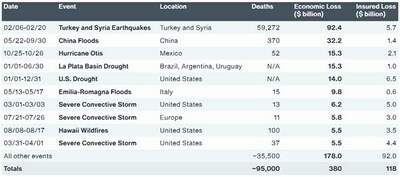Number of Billion-Dollar Disasters in 2023 Highest on Record: Aon Report
- None.
- None.
Insights
The figures presented in the Climate and Catastrophe Insight report indicate a significant rise in economic losses due to natural disasters, surpassing the 21st-century average by 22%. This increase suggests a trend towards greater frequency or severity of catastrophic events, which may have a ripple effect on global economic stability. The protection gap of 69% is particularly concerning, as it reveals a substantial portion of economic losses is not covered by insurance. This gap can lead to a financial strain on governments and taxpayers, who often bear the cost of recovery in uninsured regions.
From an economic standpoint, the data implies a need for a reassessment of risk management strategies and investment in resilient infrastructure. The trend towards more frequent billion-dollar loss events signifies that businesses, especially in high-risk industries like construction, agriculture and real estate, may face increased operational and financial risks. This situation could lead to higher insurance premiums, shifts in investment strategies and a potential reevaluation of asset values in vulnerable areas. The long-term implications may include the redirection of capital towards more sustainable and resilient economic practices.
The report's indication of a 31% insurance coverage of total losses and a record number of billion-dollar insured loss events in 2023 underscores the substantial impact on the insurance industry. The persistent increase in insured losses above the century's average challenges insurers to adjust their underwriting practices and pricing models to account for the heightened risk. The insurance sector's ability to innovate and offer new products that bridge the protection gap is crucial.
Insurers may need to consider diversifying their portfolios, investing in advanced predictive analytics and developing more comprehensive coverage options to mitigate their exposure to catastrophic events. The industry's response to these challenges will likely influence its financial health and could drive the evolution of insurance products. The emphasis on protecting underserved communities and enhancing financial resilience through insurance innovation could lead to increased market penetration and the development of more tailored insurance solutions.
The report's findings on the deadliest year since 2010 and the hottest year on record with unprecedented temperature anomalies underscore the urgency of addressing climate change and its impact on natural disasters. The highlighted need for better enforcement of building codes, maintenance of infrastructure and reliable warning systems points to a gap in current environmental policies and disaster preparedness.
Policy responses to these findings could involve stricter environmental regulations, incentives for sustainable development and increased funding for climate adaptation and mitigation strategies. The role of public-private partnerships in enhancing resilience is also accentuated, suggesting a move towards more collaborative approaches to risk management. The long-term benefits of such policies could not only reduce the human and economic toll of natural disasters but also contribute to the broader goal of sustainable development.
- Annual Climate and Catastrophe Insight report reveals global economic losses from natural catastrophes reached
- Insured losses reached
- 95,000 fatalities resulted in deadliest year since 2010
The report reveals that the 398 global natural disaster events caused a
Global insurance losses during the year were 31 percent above the 21st-century average, exceeding
The number of large-loss natural hazard events reached record levels in 2023, with
The report highlights that 95,000 people globally lost their lives due to natural hazards in 2023 – the highest number since 2010 – resulting largely from earthquakes and heatwaves. In terms of climate, 2023 was the hottest year on record with 'unprecedented temperature anomalies', and all-time highs observed in 24 countries and territories.
"Amidst increasing volatility and complexity, there is a significant opportunity for organizations to become more resilient to the climate and catastrophe risks highlighted in our report," said Greg Case, CEO of Aon. "By working across the private and public sector we are accelerating innovation, protecting underserved communities and better addressing the economic impacts of extreme weather to create more sustainable outcomes for businesses and communities around the world."
Andy Marcell, CEO of Risk Capital and CEO of Reinsurance at Aon, added: "The findings of the report highlight the need for organizations – from insurers to highly impacted sectors such as construction, agriculture and real estate – to utilize forward-looking diagnostics to help analyze climate trends and mitigate the risk, as well as protecting their own workforces. Risk managers can take advantage of increasingly sophisticated tools and leverage analytics to unlock capital and make better decisions. Equally, the insurance industry plays a critical role in improving the financial resilience of communities within their portfolios and taking the opportunity to bridge the protection gap with new and relevant products."
With efforts to limit global warming, investors can consider climate change from three perspectives: protecting their portfolios against financial risks; benefiting from growth opportunities in climate solutions, and determining how to have a positive impact and play a role in a world moving to net-zero.
"The report highlights how communities can be vulnerable to disasters in different ways. For example, earthquakes in 2023 highlighted underinsurance and the importance of regulation and enforcement of building codes," said Michal Lörinc, head of Catastrophe Insight at Aon. "In addition, deadly floods – notably in
The top 10 global economic loss events in 2023 were:
Aon's 2024 Climate and Catastrophe Insight report can be found at the following link:
https://aon.io/2024-cci-report
About Aon
Aon plc (NYSE: AON) exists to shape decisions for the better — to protect and enrich the lives of people around the world. Our colleagues provide our clients in over 120 countries and sovereignties with advice and solutions that give them the clarity and confidence to make better decisions to protect and grow their business.
Follow Aon on LinkedIn, X, Facebook and Instagram. Stay up-to-date by visiting Aon's newsroom and sign up for news alerts here.
Aon
Media Contact
mediainquiries@aon.com
Toll-free (
International: +1 312 381 3024
![]() View original content to download multimedia:https://www.prnewswire.com/news-releases/number-of-billion-dollar-disasters-in-2023-highest-on-record-aon-report-302042061.html
View original content to download multimedia:https://www.prnewswire.com/news-releases/number-of-billion-dollar-disasters-in-2023-highest-on-record-aon-report-302042061.html
SOURCE Aon plc.
FAQ
What is the main focus of Aon plc's 2024 Climate and Catastrophe Insight report?
What were the global economic losses from natural catastrophes in 2023 according to the report?
What were the insured losses from natural catastrophes in 2023?
How many fatalities were recorded in 2023 according to the report?









